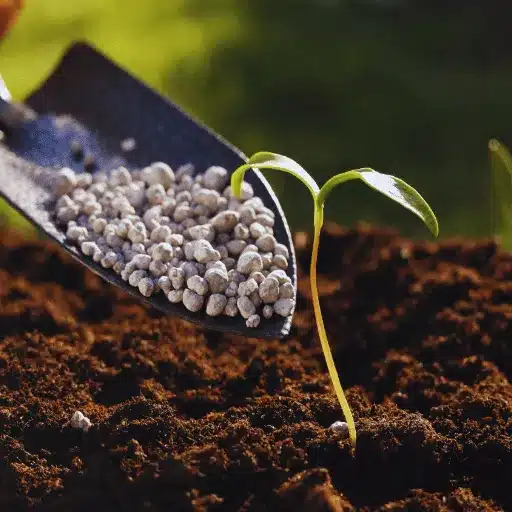In growing healthy and productive fruit trees, choosing the right fertilizer great step considered most crucial by the gardener or the orchardist. Among many choices, 16-16-16 may be considered because it has fewer nutrients in balance. But is the said fertilizer suitable for your fruit trees? This complete guide will cover everything from what 16-16-16 fertilizer contains to its benefits and drawbacks. Whether you are a commercial grower or an amateur, this article will provide you with the necessary information to decide in favor of healthy trees and better fruit production.
Understanding 16-16-16 Fertilizer
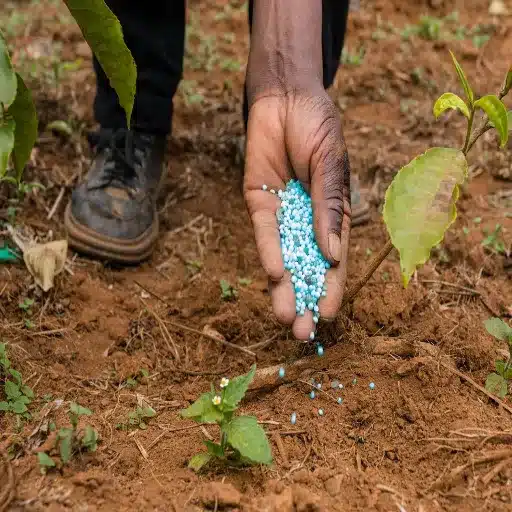
What is 16-16-16 Fertilizer?
16-16-16 fertilizer is a balanced, general-purpose fertilizer with the nitrogen, phosphorus, and potassium content present in equal ratios and at a concentration of 16% each. Growth-promoting substances for plants are three types of chemicals that form nitrogen to develop healthy leaves and phosphorus to support the development of roots and flowering, whereas potassium, generally considered to promote plant strength, aids in their resistance to stress. The fertilizer with such an unvarying composition can be used for all types of plants, namely fruit trees, vegetables, lawns, and ornamentals.
The balanced nature of 16-16-16 fertilizer absorbs a whole spectrum of nutrient requirements by plants in one application, thereby reducing the need for any further application of supplementary fertilizers. It is, however, applied where profound nutrient deficiency does not exist in soils, but nutrients need replenishing so as to retain productivity. In addition, the granular form is most common for field application and is easy to broadcast. It slowly releases nutrients in the soil, allowing plants to absorb them over time.
⚠️ Important Note: Things, however, must be handled cautiously when dealing with 16-16-16 fertilizers. This indeed is a very balanced mixture which is, however, not considered to be suitable for all occasions as a uniform ratio of nutrients may not be compatible with the peculiar requirements of a few crops or soils whose needs are unevenly balanced. In excess, the nutrients may also run off, thus causing environmental hazards or creating an imbalance in the soil. It becomes, therefore, very important, before mixing 16-16-16 into 16-16-16 fertilizer, to consider testing the soil and planning carefully.
Composition of 16-16-16: The NPK Breakdown
Being balanced and all-purpose, a 16-16-16 fertilizer contains an equal ratio of N, P, and K, with 16% for each. Such a standard formulation makes it serve different plant varieties, supplying them necessarily with equal measures of nutrients. The label ’16-16-16′ refers to the formulation of weight percent of nutrients, indicating that each 100-pound bag contains 16 pounds of nitrogen, 16 pounds of phosphorus, and 16 pounds of potassium.
Nitrogen helps the plant to grow vital green foliage. Phosphorus is responsible for root development and energy transfer while also getting involved in various flowering processes. Potassium, health-wise, empowers the plant by reinforcing disease resistance, water regulation, and the quality of fruits and flowers. All with almost equal amounts, meaning that none of the nutrients is overly administered with respect to the others; thus, it becomes apt for general application.
Although 16-16-16 offers equal proportions of nutrients, individual crop or soil needs may also vary. For instance, leafy greens may require more nitrogen, while flowering crops might prefer more phosphorus. The soil must be tested to see if this fertilizer meets its specific nutrient needs. Applying in unsuitable conditions or without any recommendation may lead to inefficiency or even environmental hazard due to over-fertilization.
Benefits of Using 16-16-16 Fertilizer for Fruit Trees
- 🌱 Promotes Balanced Nutrient Supply: The 16-16-16 fertilizer contains an equal proportion of nitrogen, phosphorus, and potassium for balanced, adequate feeding of the primary macronutrients that fruit trees require for healthy growth. Nitrogen favors foliage and branch growth, phosphorus promotes root and flower development, while potassium nourishes the tree altogether and makes the fruit ripe.
- 🍎 Increases Fruit Yield and Quality: The regular application of 16-16-16 fertilizer can ensure fruit production in good numbers and give fruits of better size, texture, and flavor. Research studies have established the fact that optimum nutrient levels, especially of potassium and phosphorus, correspond to high yield and marketable value of crops such as apples, oranges, and peaches.
- 🌿 Improves Root Development: Phosphorus in the fertilizer plays a major role in the formation of a strong, widespread root system in fruit trees. That enhances the trees’ ability to absorb water and nutrients from the soil, thereby making them healthy and hardy.
- 🛡️ Supports Disease Resistance: Potassium in 16-16-16 fertilizer strengthens tree tissue so that fruit trees become less vulnerable to diseases and environmental stresses such as drought or frost. Research has revealed that potassium contributes to increased plant resistance to attacks by major pathogens.
- ⚡ Simplifies Application Process: The single nutrient ratio avoids the need to work with a whole range of fertilizers of specific nutrients, thus making fertilizing easier for the grower. All this is a boon for large orchards, as it saves time and labor and provides an even balance of nutrients in the soil.
Evaluating Nutrient Needs of Fruit Trees
Identifying Nutrient Deficiencies in Fruit Trees
Identifying deficiencies of nutrients in fruit trees is important to uphold the supreme health and to maximize the potential for yield. Usually, the signs and symptoms of deficiencies are noticed with visual changes in the leaves, fruits, or the vigor of the entire plant. For instance, nitrogen deficiency usually causes older leaves to develop a pale green or yellow coloration because of a reduced formation of chlorophyll, thus affecting photosynthesis. In some situations, phosphorus deficiency causes stunted growth along with dark green or reddish-purple leaves. At the same time, potassium deficiency makes the edges of the leaves brown and scorched, mainly along mature foliage.
Correct diagnosis of nutrient deficiency requires the consideration of environmental conditions, soil properties, and the nutrient requirements of the plant species concerned. Soil testing, with its exact data on nutrient composition, pH, and total organic matter, forms the foundation of the diagnosis pipeline. Foliar analysis can complement soil testing data by providing the concentration of nutrients in plant tissues, revealing insightful information on the present nutrient health of plants.
Using precision agriculture tools, remote sensing, and plant nutrient sensors, real-time feedback about the nutrient status throughout the orchard is offered to the grower. Combining these technologies with reference manuals and agronomic databases paves the way for highly efficient interventions. Interventions primarily involve modification of the fertilizer type, the application rate, or mode of application to effectively address the deficiency in some nutrients so that fruit trees remain productive and healthy in the long run.
How 16-16-16 Meets the Nutrient Requirements
16-16-16 fertilizer, or a balanced NPK fertilizer, contains N, P, and K in equal quantities of 16%. As such, it serves as a general-purpose fertilizer to fulfill the basic nutrient requirements of the plants. Nitrogen is involved in the vigorous vegetative growth of plants, the development of canopies, and the efficiency of photosynthesis. Phosphorus is important for root development and the processes of flowering and fruiting. Potassium increases the resilience of plants with water-regulating cells to endure stressful conditions.
The 16-16-16 nutrient ratio has uniformity, and this is especially beneficial for crops and orchards that may demand the frequent application of nutrients. Considerations are given to balancing nutrient supplies and avoiding an abundance of one nutrient while neglecting others, which can cause nutrient lockout or deficiencies. Agronomic studies have indeed pointed out that such a balanced composition fits well with the growth needs of almost all kinds of crops in various growth phases, especially when field soil testing reveals a general deficiency rather than a specific nutrient deficiency.
When installed with advanced peculiar independence monitoring technologies, such as tissue analysis, soil testing, and nutrient prediction modeling, the appropriate application rate of 16-16-16 can be set with surgical precision. Any of these tools may provide data on when the fertilizer might apply most efficiently, that is, when there is a certain amount of uptake by the plants. Preventing likely leaching or volatilization, this approach best serves environmental considerations and crop yield potential as counterparts.
Comparing 16-16-16 with Other Fertilizer Types
| Aspect | 16-16-16 | 10-10-10 | 20-20-20 | Organic | Slow-Release |
|---|---|---|---|---|---|
| Formula | 16-16-16 | 10-10-10 | 20-20-20 | Variable | Variable |
| Balance | Equal | Equal | High | Natural | Gradual |
| Purpose | General | General | Intensive | Eco-friendly | Sustained |
| Ease | Simple | Simple | Moderate | Laborious | Minimal |
| Expense | Medium | Low | High | Variable | High |
| Eco-Friendly | Moderate | Moderate | Low | High | High |
Best Practices for Fertilizing Fruit Trees
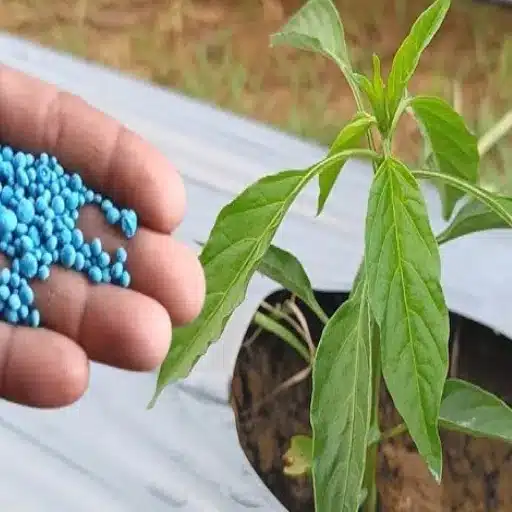
Step-by-Step Guide to Applying 16-16-16 Fertilizer
The correct timing of fertilization with this kind of fertilizer ensures that the trees absorb nutrients most efficiently for their health. The following directions should be followed for proper application:
- 1
Determine the Appropriate Timing: In early spring, well before the obvious growth of the trees, fertilize with 16-16-16. If the requirements arise mid-growth, a secondary application might be necessary depending upon soil nutrient status or visual cues of deficiency. - 2
Assess the Tree’s Nutritional Needs: A soil test is done to measure nutrient levels, especially nitrogen, phosphorus, and potassium. Use the test results for confirmation if the 16-16-16 fertilizer will really cater to the needs of the tree, as it is balanced in terms of major nutrients. - 3
Calculate the Application Amount: Measure the diameter of the tree at breast height (approximately 4.5 feet above the ground). - 4
Prepare the Application Zone: Clear the open space beneath the tree canopy without disturbing the base of the trunk. This free space is known as the drip zone and marks the most active root absorption area. Applying fertilizer on moist soil increases nutrient absorption; hence, it is beneficial to slightly moisten the soil before application. - 5
Distribute the Fertilizer Evenly: Scatter the fertilizer evenly on the drip line; do not let the fertilizer touch the trunk, as it may cause burning. Where larger trees are concerned, the total amount should be split into two or three applications spaced at least a few weeks apart to allow proper nutrient release. - 6
Incorporate the Fertilizer into Soil: Rake lightly such that fertilizer remains incorporated within the top 1-2 inches of soil. This process promotes nutrient absorption by fostering fertilizer contact with feeder roots. - 7
Water the Area Thoroughly: Upon applying the fertilizer, water the area thoroughly to dissolve granules and allow nutrients to be transported down to the root zone. Avoid excess watering, as this could cause runoff or leaching of nutrient elements. - 8
Monitor Tree Health: Observe a tree’s growth. Lush, healthy leaves and steady growth suggest that nutrients are well-absorbed. Should the deficiency’s symptoms become worse, review soil conditions and fertilizer applications.
Following these detailed steps will allow a grower to reap the benefits from 16-16-16 fertilizer, helping his fruit trees to grow actively and bear more fruit. Remember to always adhere to the manufacturer’s instructions so that the fertilizer can be applied safely and properly.
Timing: When to Fertilize Your Fruit Trees
Though fertilizing fruit trees during the correct period is important in ensuring vigorous growth, maximal fruit yield, and nutrient balance, it is always convenient to follow a general guide that dictates applying fertilizer in early spring before any new growth begins. Fertilizer application is highly recommended when the tree begins to actively take in nutrients to support bud, leaf, and early-stage fruit development.
For the younger trees, thus establishing their root systems, fertilization once a year during this period is preferred to maintain the steady growth; On the other hand, mature fruit trees may even benefit from an extra application of fertilizer in late spring or early summer when the tree is building nutrients for fruit development and ripening. Applying fertilizer in late summer or fall isn’t a good idea because late fertilization stimulates new growth that would then be susceptible to winter damage.
Besides that, climatic variations affecting regional schedules and specific tree species, ascertaining fertilization timing, are the two factors that influence the fertilization schedule to be used. In some temperate zones, fertilizer application is usually best in early April. However, in warmer climates, late February to early March might be preferred. Always observe the growth stage of your trees and local weather conditions to adjust your fertilization schedule. For a bit more precision, soil testing can provide detailed nutrient information to help tailor fertilizer application to your orchard’s exact requirements.
Common Mistakes to Avoid When Using Fertilizer
- ❌ Overfertilization: One of the most common mistakes is overfertilization. This extreme fertilization causes runoff carrying nutrients into the adjoining water bodies, which invites threats, including algal blooms. Overfertilization can begin to harm plant roots and further lead to the buildup of salts in the soil, thereby obstructing plant growth and yields.
- ❌ Using the Wrong Fertilizer: Choosing a fertilizer without knowing the nutritional requirements of the soil is another grave mistake. For example, adding nitrogenous fertilizer to a soil already rich in nitrogen could create an imbalance that inhibits plant growth while ignoring other important nutrients. A check or test of the soil should be made before fertilization to make sure that the right nutrients are included.
- ❌ Wrong Time of Application: Application of fertilizers at the wrong time: too early, too late, or under extreme weather conditions will greatly reduce the efficacy of the fertilizers that are getting applied. Fertilizer application immediately before heavy rainfall may result in nutrient leaching, while late fertilizers-in-soil applications might reduce plant maturity or hardiness in colder climates.
- ❌ Inequality of Application: With unbalanced fertilization, there extend the growth processes within a field are extended physically, with some areas experiencing nutrient deficiency and others nutrient toxicity. If fertilizer is calibrated and spread evenly, the implementation of fertilization ensures that different plants actually receive an adequate supply of nutrients.
- ❌ The Ignorance of Specific Requirements of Plants: In the perfect world of a plant, each crop or tree species is expected to have different nutrient needs that have to be fulfilled for ultimate development. A one-fertilizer-fits-everyone method will most likely lead to wasted resources or less-than-ideal yields. Customized fertilizer programs according to species and growth stages are a must for any fertilizer.
In the course of avoiding these usual violations and by following the good practices, one benefits from optimum fertilizer use, less environmental implication, and healthier crop or orchard giveback. Remember that the best results come with proper soil analysis, targeted applications, and up-to-date agronomic practices.
Specific Considerations for Different Fruit Trees
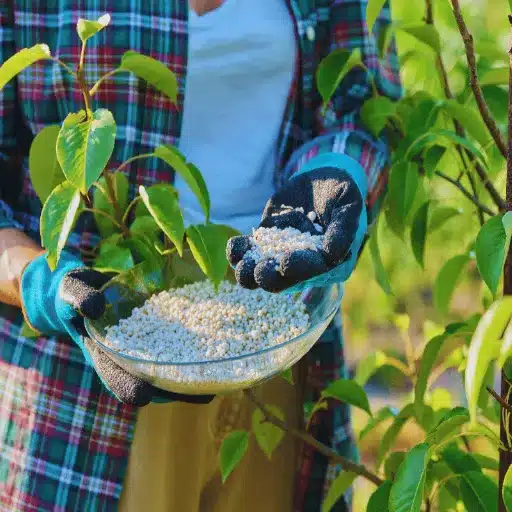
Fertilizing Apple Trees with 16-16-16
It is necessary to maintain a balance in 16-16-16 fertilizer containing nitrogen, phosphorus, and potassium, at equal ratios, for optimum apple tree growth and fruit production. The nutrients are given in suitable quantities to sustain the overall health of the tree, as well as fruit and root development. The application of this fertilizer, to maximize its effect, should be tailored to the growth stage of the apple tree and nutrient requirements, as revealed by soil analysis, if need be.
Use a little fertilizer and evenly distribute around the dripline of non-bearing, young apple trees in early spring to spur vegetative growth. Mature, bearing trees should be fertilized twice on a split application, first early in spring before bud break, and secondly in late spring to early summer during fruit development phases. The amount of fertilizer applied depends on the age of the tree, normally 0.3 to 0.6 pounds of fertilizer per year of tree age, but in no case more than ten pounds per tree yearly.
Fertilizer must never be placed too close to the trunk to avoid damage to the roots. Fertilizer should be spread evenly within the drip zone of the tree and well watered afterwards, so the nutrients can percolate into the root zone. Adjustments on the rate of application should be made regularly based on soil and leaf tissue testing to maintain nutrient balance, avoid over-fertilization, which may cause environmental hazards or excessive vegetative growth at the expense of fruit yield. Proper utilization of the chemical fertilizer 16-16-16 with the current farm practices and monitoring guarantees the best performance of trees and the sustainable management of the orchards.
Best Practices for Peach Trees
Optimal health and vigorous productiveness are gained through good cultural practices-only proper care, nutrients, and environmental monitoring. Pruning is vital to keep the tree shape, provide sunlight, and air circulation economically, which helps in reducing the occurrence of diseases and enhances the fruit quality. In late winter, while the trees are still dormant, peach trees should be pruned yearly to develop an open center canopy, which allows the maximum amount of sunlight.
Irrigation management is very crucial for tree performance during the main growth stages. Peach trees require moisture on an almost consistent basis during flowering, fruiting, and after-harvest recuperation. Using drip irrigation or other methods that apply water precisely only to the water of the root zone is a worthy endeavor to facilitate proper growth and conserve water.
Pest and disease control must be considered an element in an integrated approach for sustainable production. Regularly inspect for common threats such as peach tree borer, oriental fruit moth, and fungal diseases like leaf curl or brown rot. Control measures will be implemented if infestation takes place; pheromone traps, biological control measures, or otherwise pesticide application can be used, and all measures must be timed so that minimal damage is inflicted on indeed beneficial organisms.
Fertilizer application should be undertaken following annual soil tests and leaf tissue analysis to meet the orchard’s specific nutrient requirements. Generally, peach trees will be supplied with balanced fertilizer, especially in late winter or early spring, containing sufficient percentages of nitrogen, phosphorus, and potassium. Excess nitrogen should be avoided as it promotes vegetative growth at the expense of fruit production.
Monitoring weather extremes such as frosts during spring or heat stress during summer allows growers to take action for protection at an opportune moment. Frost protection systems are installed for use during frost, and shade nets are installed when heat stress seems probable. Meteorological data are reviewed for adaptation in decision-making to protect the yield and tree health.
How to Fertilize Pear Trees Effectively
Pear trees need to be fertilized strategically, which means supplying nutrients according to their growth requirements and preventing any nutrient imbalance in the soil. Starting with a soil test usually gives a good idea regarding baseline nutrient levels for N, P, K, and pH. The pH for pear trees is usually good if it falls between 6.0 and 7.0. An amendment might be necessary if the soil is on either the acid or alkaline side, since, in any case, nutrients will not be absorbed efficiently because of improper pH.
Nitrogen is the major nutrient responsible for pear tree vigor; however, extravagant applications of nitrogen will make growth more vigorous than desired, flowers less abundant, and prone to diseases, such as fire blight. For young trees, about 0.05-0.1 pounds of actual nitrogen per growing year, up to 0.5 pounds annually, should be applied. Mature trees usually require 0.1-0.25 pounds of actual nitrogen per inch of trunk diameter at chest height. Adjust this to match phosphorus and potassium needs, which promote strong root development, flowering, and fruit quality.
Also, the application time is crucial for fertilization. Apply nitrogenous fertilizers just before bud break, early in the spring. Avoid late-season applications, as such applications stimulate growth that is subject to winter damage. Organic fertilizers like compost or well-rotted manure can be used to enhance soil structure and provide nutrient availability over time.
Depending on soil conditions and visual deficiencies in the trees, more boron or zinc may be required as additional nutrition. Such treatments through foliar sprays facilitate selective and quick uptake. Eventually, orchardists should maintain detailed records of fertilizer applications and observations on plant performance to refine the nutrient management strategy. With a research-based approach, pear growers can assure constant yields and foster orchard conservation.
Expert Tips and User Experiences
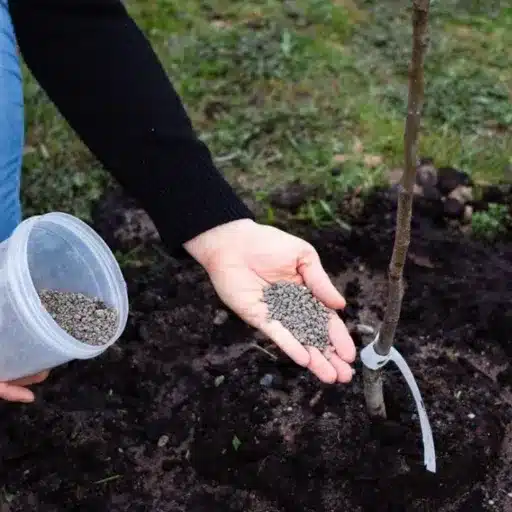
Expert Advice on Fertilizing Fruit Trees
I always emphasize soil testing as the priority when fertilizing fruit trees. A thorough soil analysis allows you to determine the best nutrient application plan for your orchard. It really tests to see if the key elements, such as nitrogen, phosphorus, or potassium, are deficient and should be supplied to produce healthy fruit. I further advise that, once in a while, it is good to repeat the test because soil nutrient status changes sometimes due to crop rotations or natural weathering.
Timing fertilization can also be crucial, and one must never ignore this factor. In my experience, fruit trees should be fertilized with most fertilizers in early spring, from the late bud to the late bud stage. This time allows nutrients to pass into the plant until early growth and flowering. Mid- to late-season fertilization of trees with high-N fertilizer should be avoided, as it promotes vegetative shoots’ growth at the expense of fruit development, which in turn may result in delayed ripening or reduced yield quality.
While fertilizing with the basics may get some response, I will suggest more diversified approaches; include organic materials such as compost or well-aged manure. The main function of organics is to improve soil texture, microbial life, and the slow release of nutrients into it. An option consists of these organics and synthetics, ensuring adequately monitored uptake so that short-term growth goals are met, along with long-term sustainability of your orchard. Keeping records of fertilization schedules, soil tests, and the tree’s responsiveness will help in the continuous assessment and slight refinement of the nutrient program.
Success Stories from Gardeners
These examples demonstrate the immense possibilities behind data-based fertilizer practice. The combination of the scientific method with ongoing observation and keeping detailed records has allowed gardeners to create a way to measure improvements in productivity and sustainability.
Alternative Fertilizers and Their Uses
Alternative fertilizers have expanded in modern-day agriculture and horticulture, particularly for soil health and sustainability issues. These fertilizers provide the essential nutrients while limiting the hazards to the environment that synthetic fertilizers normally cause.
- 🌿 Compost: Safely prepared compost from controlled decomposition of organic matters such as food waste, leaves, and manure acts as a nutrient-rich soil conditioner. It develops the soil structure, increases microbial activity, and improves water retention properties. Studies reveal that a normal application of compost can reduce the use of chemical fertilizers by 30%, thus lowering both cost and ecological footprint.
- 🦴 Bone Meal: As a slow-release form of phosphorus and calcium, bone meal is very good for root development and flower formation. The main benefits lie in enhancing root crops such as carrots and potatoes. In accepting bone meal applications made within reason, phosphorus build-up in the soil is prevented, thereby making sure nutrients remain available in the long run.
- 🪱 Vermicompost: This is a well-nourished form of organic matter produced when earthworms digest organic residues. It supplies plants with highly bioavailable nutrients, promotes nitrogen fixation in the soil while inhibiting diseases, and affects microbial diversity. Research has shown an increase of 20-25% in seed germination rates with vermicompost application as against untreated soil.
- 🌊 Seaweed Extracts: Contains micronutrients such as iodine, potassium, and magnesium in liquid or powder forms to provide nutrients. Increase stress resistance in plants and improve metabolic functions. It has been noted that seaweed fertilizers increase crop yields under dry environmental conditions by enhancing mechanisms of drought resistance.
- 🍀 Green Manure: This practice involves growing specific crops like clover or alfalfa and then tilling them back into the soil to replenish nitrogen, suppress weeds, and increase soil organic matter. Research, however, has shown that green manure can reduce the need for application of synthetic nitrogen fertilizers by up to 40% in crop rotations.
- ⚫ Biochar: Biochar is basically a porous carbonaceous material prepared from the pyrolysis of any organic biomass and intended to improve the fertilizing capacity of the soil by adsorbing nutrients and increasing cation exchange capacity. It is especially useful in acidic soils and for carbon sequestration over a long period of time, thus complementing climate-resilient agriculture.
When applied correctly at the right time, these alternate fertilizers can provide for the proper growth of plants while maintaining ecological balance. Present studies and field trials keep bringing new information up to corroborate the rapid transition made towards more sustainable and informed fertilization practices.
Frequently Asked Questions (FAQ)
Q: Is 16-16-16 fertilizer good for fruit trees?
A: If you ask me, 16-16-16 fertilizer will do great for fruit trees as they get an even supply of nitrogen, phosphorus, and potassium. This all-purpose fertilizer promotes general health and makes fruit trees bear bigger fruits while vigorously growing.
Q: The fertilizer needs of fruit trees would be how much?
A: Fertilizer needs of fruit trees depend more on the age of the trees and the size and requirements of nutrients needed by the tree. Usually, young trees don’t need that much fertilizer, but an older tree might have to be fertilized more to ensure growth and fruit production.
Q: What is the optimum time for fertilizer application in fruit trees?
A: The best time for fertilizer application would be in early spring, just when the trees start their growth; fertilizer application would support the trees’ growth throughout the growing period.
Q: How does 16-16-16 fertilizer compare to 10-10-10 fertilizer?
A: Though both fertilizers are balanced, 16-16-16 offers the highest concentration of nutrients, thus higher amounts of nitrogen, phosphorus, and potassium are applied with every treatment; this would fit trees requiring feeding for optimum growth.
Q: How does one calculate the actual amount of fertilizer to apply?
A: The essential elements for calculating fertilizer application amounts include the tree’s age and size, as well as its nutrient requirements. The common saying is an application of one pound of fertilizer for each year of the tree’s life, capped at a target amount based on the tree’s size.
Q: Will 16-16-16 fertilizer be good for citrus trees?
A: Yes, the 16-16-16 fertilizer will help citrus trees with nutrient requirements for normal growth and fruiting. However, attention to the particular nutrient needs of trees and adjusting accordingly is fundamental.
Q: Can I use 16-16-16 fertilizer for stone fruit trees?
A: Yes, stone fruit trees like peaches and cherries can be treated with a 16-16-16 fertilizer. Fertilization depends on the intrinsic mix, which promotes tree growth and improves the quality and size of the fruit.
Q: What other fertilizers can I use for fruit trees?
A: Besides 16-16-16 fertilizers, there are organic fertilizers to consider or specialized nutrient mixes containing micronutrients like boron or zinc. All could serve their purpose for addressing ill effects related to nutrient deficiencies, thereby giving rise to better fruit development.
Q: How do I apply fertilizer to fruit tree roots?
A: Fertilizer should be applied evenly on the root zone of a tree, but not in contact with the trunk. This ensures nutrient absorption by the roots and will guarantee healthy root growth.
References
-
- University of California Agriculture and Natural Resources (UCANR)– Talks about the use of the 16-16-16 fertilizer for fruit trees.
- University of Florida IFAS Extension – Distils the fertilizing of fruit trees and the favorable ratios.
- Oregon State University Extension Service – Treats methods of fertilizer application, including 16-16-16, for diverse crops.
- Clemson University Home & Garden Information Center – Gives information for fertilizing peach trees with the different types of fertilizers.
- Stevens County Government – Soil Guide – Covers fertilizers and their benefits, including those rich in phosphorus.
- Click here to read more.



